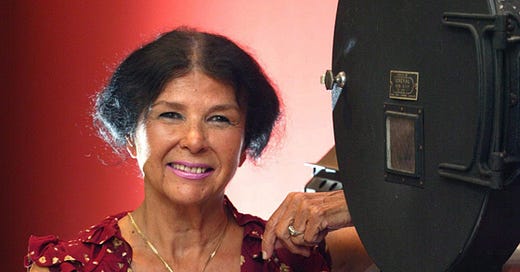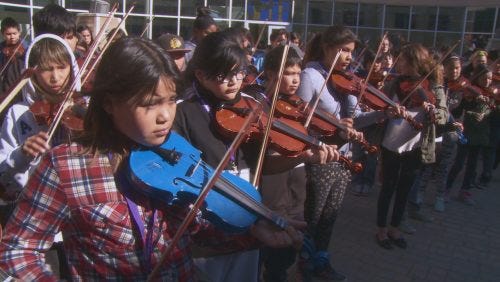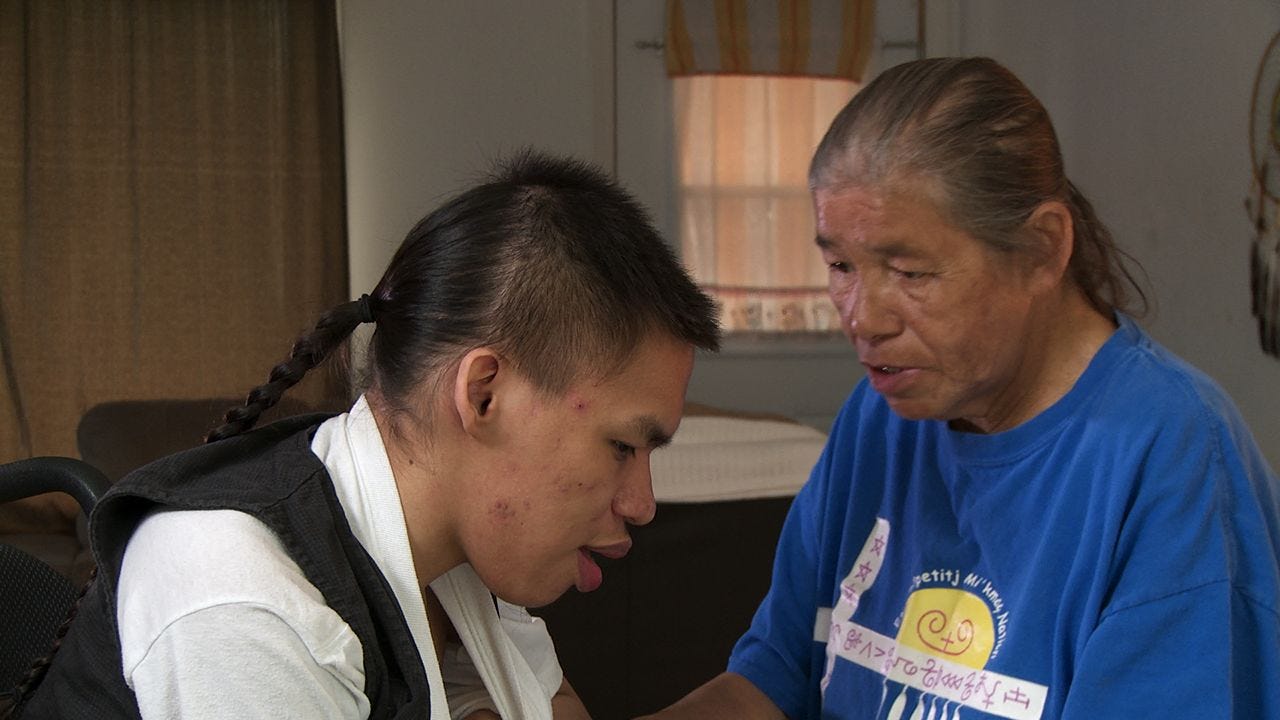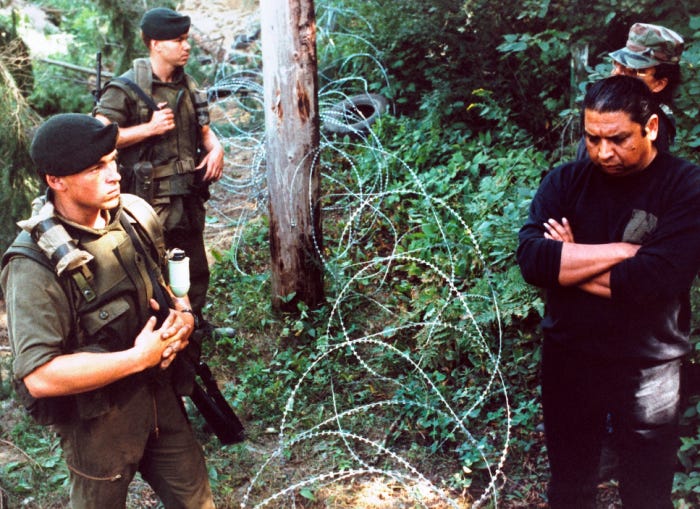Alanis Obomsawin documents Indigenous history
Obomsawin, a member of the Abenaki Nation, is without a doubt, the foremost documentary film maker and authentic chronicler of Indigenous life.
Alanis Obomsawin Credit: National Film Board of Canada
June is National Indigenous History Month! Fittingly, the National Film Board of Canada (NFB) is promoting Alanis Obomsawin’s most recent film, My Friend the Green Horse! (NFB/2024/11mins).
Available free on the NFB website, My Friend the Green Horse is a brilliant blend of stop-motion animation and live action that recalls the true story of acclaimed filmmaker Alanis Obomsawin’s childhood refuge in a dream world rich with animal spirits.
The Green Horse proves to be a tender and wise companion who, along with other animal spirits, guides young Alanis through visions of her homelands. Alanis’ nightly adventures help her learn to embrace life’s beauty and to live with compassion.
This short, yet powerful film, is a poetic tribute to the lasting gifts of childhood imagination, cultural memory and spiritual connection that children and adults alike can enjoy, appreciate and learn from.
For those readers less familiar with Obomsawin’s extensive body of work here’s a very brief overview of her oeuvre that exposes systemic racism; government deceptions; double standards; illegal expropriation of sacred burial lands; a lack of political will to implement government bills to the point of challenging non-compliance orders issued by the Canadian Human Rights Tribunal.
These are the truths Canadians must understand and acknowledge before they can start dismantling institutionalized Indigenous racism.
Obomsawin is a member of the Abenaki Nation, whose traditional lands include parts of southeastern Quebec and northern New England. Obomsawin is without a doubt Kanata's — so-called Canada’s — foremost documentary film maker.
Obomsawin introduced Canadians to the untenable conditions Indigenous Peoples have endured since colonization. She has also deconstructed stereotypes perpetuated by various levels of government intent on the systematic, silent, secretive genocide of Indigenous Peoples. And, at 92 years of age, Obomsawin shows no signs of slowing down.
Obomsawin began her career as a singer-song writer and story teller performing across Canada, the US, and Europe. In 1961, while singing at a prison, Obomsawin discovered that an astonishing 68 per cent of the inmate population was Indigenous. That prompted her to go on a tour of jails.
Then, she began going into courtrooms to watch how the judicial system treated First Nations, Inuit and Metis men and women. In a 2017 interview I had with her at the NFBs Toronto office, Obomsawin described the experience as, "Horrifying because all I was hearing was guilty, guilty, guilty. There was disrespect towards Indigenous people from duty counsel, the crown and judges. Indigenous people were expected to just shut up and accept that they were going to be found guilty because the decision had been made based on the fact that they were Indigenous."
Obomsawin began filming what was happening inside courtrooms. At the time of the interview Obomsawin said, "Today there is respect in court. This is a great gift and we are going to a better place."
However, those evolutions are often difficult to see when Jordan’s Principle remains unresolved after decades of unsuccessful legal battles launched by both Conservative and Liberal federal governments.
Obomsawin’s enthusiasm, determination and love of filmmaking are profound. Obomsawin said, "Documentary making is very exciting. I'm still as excited as when I made the first film. I still have a passion for it. And, these documentaries are a history now for education."
Make some time this month to watch Obomsawin’s beautiful, groundbreaking and often infuriating films – think Jordan’s Principle and Kanehsatake. All the films featured in this piece are available for viewing free on the NFB site.
Former Senator Murray Sinclair Credit: National Film Board of Canada
Honour to Senator Murray Sinclair (NFB/2021/29 mins) made its world premiere at the 2021 Toronto International Film Festival (TIFF) as part of the Celebrating Alanis Retrospective.
In this beautiful homage to Calvin Murray Sinclair, Obomsawin shares the powerful speech made by the former senator and chair of the Truth and Reconciliation Commission (TRC) Murray Sinclair when he accepted the World Peace Award from the World Federalist Movement Canada in 2016.
Obomsawin artfully interspersed Sinclair’s talk with the heart-wrenching testimonies of Iris Nicolas, Victoria Crowchild, James Yellow Knee, Paul Voudrach, Ida Embry and Saul Day — all of whom were imprisoned at residential schools as children.
As the chair of the TRC, Sinclair was a key figure in raising global awareness of the atrocities meted out through Canada’s residential school system. The TRC grew out of the residential school settlement agreement. It was largely controlled by the Harper government, who insisted that only the term cultural genocide be included in the report.
Sinclair, Anishinaabe and a member of the Peguis First Nation, inherited a TRC in chaos. A year later, in 2010, the commission held its first national event in Winnipeg, Manitoba. Over 20,000 folks attended to bear witness to the traumas endured by residential school survivors.
In June 2015, the final report — including 94 Calls to Action — was released. According to Indigenous Watchdog, “The federal government is accountable for 76 of the 94 Calls to Action – either alone or in partnership with the provinces and territories. As of January 1, 2024, according to Indigenous Watchdog, 11 of those Calls to Action are COMPLETE and 39 are IN PROGRESS. That represents 66 per cent of the C2A!”
The site also states, “Of the 65 Calls to Action that the government claims are well under way – excluding the 11 that are complete – 26 Calls to Action or 40 per cent are either NOT STARTED or STALLED.”
Sinclair asked us to look to the United Nations Declaration on the Rights of Indigenous Peoples (UNDRIP) to create the framework for reconciliation. Adopted by 144 nations on September 13, 2007, Canada, the United States, Australia and New Zealand voted against UNDRIP.
While Canada endorsed UNDRIP in 2010, adoption only took place in May 2016 and UNDRIP is still not legally binding in Canada.
Seven generations of stolen children were imprisoned in residential schools. Yet, Sinclair reminds us the public school system also had devastating effects on Indigenous children often treating them as “less than.” Curriculums continue to omit Indigenous contributions to the history of this country, cultivating an air of superiority in non-Indigenous children. As Sinclair sagely observed, reconciliation will take generations to achieve.
With determination, wisdom and kindness, Sinclair remained steadfast in his belief that the path to actual reconciliation between Indigenous and non-Indigenous people requires understanding and acceptance of often difficult truths about Canada’s past and present.
Sinclair challenged Canadians to choose one Call to Action and make it happen. Now, that would be a fitting tribute to Murray Sinclair’s life, his work and his memory.
Honour to Senator Murray Sinclair reminds us to honour the lives and legacies of the tens of thousands of Indigenous children taken from their families, communities and cultures while leaving viewers with a profound feeling of hope for a better future.
Fiddle class at the Helen Betty Osborne Ininiw Education Resource Centre Credit: National Film Board of Canada
Our People Will Be Healed (NFB/2017/97 min). Norway House is one of the largest First Nation communities in Manitoba. Located 456 kilometers north of Winnipeg, the community grew from a Hudson's Bay fur-trading post near the outlet of Lake Winnipeg. Norway House was named for the Norwegian labourers who constructed the post's buildings.
Obomsawin’s beautiful film explores the history and healing power found in the Helen Betty Osborne Ininiw Education Resource Centre as the centre’s teachers help their students develop their abilities along side a sense of pride by enriching their lives through the power of education.
Scene from We Can’t Make the Same Mistake Twice Credit: National Film Board of Canada
Jordan River Anderson has been the focus of two Obomsawin documentaries starting with We Can’t Make the Same Mistake Twice (NFB/2016/2hrs 42mins) which documented the nine-year legal saga that pitted Indigenous folks against the Harper government. At issue was the deplorable quality of services provided to children and youth on reserve.
In a 2016 phone interview, Obomsawin told me she made the documentary because, “I feel much higher than hope that there’s a possibility for big changes. People are ready to watch and listen to what the story really is. It’s a very different time for our people.”
Jordan’s Principle, which passed unanimously in the House of Commons on December 12, 2007, was a private member’s motion based on the child first approach that was to be invoked when there were intergovernmental disputes over payment for services. But then Prime Minister, Stephen Harper, fought Jordan’s Principle tooth and nail even trying, but failing, to find dirt to discredit renowned Indigenous children’s advocate Cindy Blackstock, Executive Director of the First Nations Child & Family Caring Society.
Justin Trudeau promised to remedy the situation when he became Prime Minister, but to date Jordan’s Principle remains unresolved.
So, guess what? The Canadian government did make the same mistake multiple times which means the choice to not act on the court’s decision was an intentional political act to subvert the rule of law.
Jordan River Anderson with his mother Credit: National Film Board of Canada
Jordan River Anderson – The Messenger (NFB/2019/1hr 5mins), the follow-up documentary to We Can't Make the Same Mistake Twice, chronicles how the short life of Jordan River Anderson generated a momentous legacy for all Indigenous children.
Jordan River Anderson was a First Nations child from Norway House Cree Nation born with complex medical needs. While the provincial and federal governments disputed who should pay for Jordan's home care, Jordan died in hospital at the age of five. He never got to see his home.
On January 26, 2016 as part of a larger decision, the Canadian Human Rights Tribunal ordered the federal government to fully implement Jordan's Principle. The federal government continues to limit the application of Jordan's Principle to children living on reserve with a disability or special needs.
Find out more about Jordan’s Principle here.
Kanehsatà:ke: 270 Years of Resistance Credit: Shaney Komulainen
In Kanehsatake: 270 Years of Resistance (NFB/1993/2hrs), Obomsawin chronicled the events that would eventually become known throughout mainstream Canada as the 1990 Oka crisis. But let’s be real, the village of Oka was never in crisis. Rather, the Kanehsatake and Kahnawake reserves and their residents were under siege and attack by various levels of government, Quebec police, the Canadian military and non-Indigenous residents of Oka, Quebec.
Obomsawin spent 78 days and nights filming the armed stand-off between the Mohawks, Quebec police and the Canadian army. This powerful piece of living history lays bare the truth faced by First Nations women, men and children behind the barricades as various levels of government attempted to propagandize and manipulate public opinion by intercepting and blocking mainstream media reports, all in the name of expanding a golf course onto sacred First Nations burial land.
"Documentaries let people speak for themselves. It's every aspect of their life. This becomes normal. Drugs and alcohol won't help. The young need to go back to themselves, their culture and way of life. Young people make the big changes. Young people have gone through bad things but are so much stronger. There is a strong movement going on with young people turning back from suicide and they deserve a life. They're returning to traditions and more and more this is how young people are talking,“ Obomsawin told me.
Hi-Ho Mistahey! (NFB/2013/1hr 39mins) tells the story of Shannen's Dream, a national campaign to provide equitable access to education in safe and suitable schools for First Nations children living on reserve.
Shannon Koostachin fought for equal funding for on-reserve schools before her life was cut short by a tragic traffic accident, but her fight continued through Indgenous youth who presented their case to the United Nations in Geneva. Yet, despite recommendations from the UN and the unanimous passing of former Timmins-James Bay NDP MP Charlie Angus's Motion 201 on February 27, 2012, not much has improved for children and youth wanting to receive their education while living on reserve.
According to Obomsawin, "Documentaries are wonderful for educating. Education needs to include real history and respecting the Nations. Classroom kids have a better understanding today of true history, especially in Ontario."
Documentaries like Hi-Ho Mistahey! are necessary reminders that Canadian governments are not providing Indigenous children and youth with the same fundamental, basic resources and rights non-Indigenous children and youth receive.
Trick or Treaty? (NFB/2014/1hr 24mins) explains the history and importance of the interpretation of Treaty 9 that covers a vast swath of northern Ontario. Treaty No. 9 reflects the often-contradictory interpretations of treaties between First Nations and the Crown.
The 1905 agreement signed in Moose Factory was accepted by First Nations because it was a treaty that enabled the two Nations to walk together in peace and prosperity Nation to Nation.
Unfortunately, First Nations leaders were misled and not given a truthful interpretation before signing a British document written in English which claims the Nations ceded their rights to all lands and resources. It becomes crystal clear that this was not the intention of First Nations leaders. It's also undeniable that all Canadians are treaty people bound to uphold these agreements.
The film does a wonderful job of explaining Bill C-45 passed by the Harper government in December 2012 which in turn gave rise to Idle No More movement and Chief Theresa Spence's six-week hunger strike.
When asked what role documentaries play in creating truthful reconciliation, Obomsawin replied, "Documentaries play a valuable role in truthful reconciliation as a record of history and how lives go to a better place – a place of decolonization and it's important to have a place like that."
For a full listing of Obomsawin’s 65 films for the NFB click here and begin watching authentic Indigenous history for free.
Thanks to everyone who read today’s article. With your continued financial support, a little Nicoll can make a lot of change.








